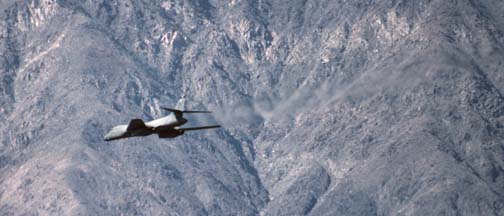

Crashes in Saline Valley
Posted by Dezdan on December 10, 2002 at 19:07:01:
In Reply to: Military Crashes in Saline Valley posted by Possum on December 09, 2002 at 20:14:44:
All I could dig up from the NTSB on crashes in saline valley are two private aircraft wrecks:
~Dezdan
Aircraft:Cessna 180J, registration: N7821k
Injuries: 2 Uninjured.
On April 5, 2002, about 1135 hours Pacific standard time, a Cessna 180J, N7821K, nosed over during landing rollout in the Saline Valley, Death Valley National Park, California. The airplane was substantially damaged. Neither the private pilot, who owned and operated the airplane, nor the passenger was injured. The airplane was being operated on a personal flight under 14 CFR Part 91. Visual meteorological conditions prevailed, and a visual flight rules flight plan was filed. The flight originated from Angwin, California, about 0944.
According to a spokesperson with the National Park Service (NPS), the airstrip's existence is not depicted on aeronautical charts. Although a windsock is present at the airstrip, no facilities exist and the airstrip is not maintained by the NPS. The spokesperson additionally indicated that the airstrip's dirt runway has a "washboard-like" contour, and in places rocks and debris from various airplanes or other vehicles have been observed in the vicinity. The airstrip has been used by pilots for years while the NPS has been evaluating whether it will continue to sanction its usage. The airstrip is located in close proximity to rising and uneven terrain, and the runway is only usable in a single direction. The airstrip is locally known as the "Chicken Strip."
The pilot reported to the National Transportation Safety Board investigator that the wind was calm during his wheel landing. The pilot stated that during rollout he encountered a hole in the runway's surface. Thereafter, the airplane veered off the runway, collided with a rock, and nosed over. No mechanical malfunctions were experienced with the airplane. During the past 90 days, the pilot has landed at the airstrip approximately 1/2 dozen times.
Aircraft:Cessna TU206F, registration: N8728Q
Injuries: 4 Uninjured.
The flight departed its home base, flew to another airport, and was returning home when the engine lost power due to fuel exhaustion. The pilot reported that he took off originally with full fuel tanks and had not refueled at the en route stop. He stated that he had the fuel selector positioned to the right tank, but he noticed that both the left and right fuel gauges indicated decreasing amounts of fuel. The right fuel gauge dropped to 'empty' and the engine suddenly quit. He switched the fuel selector to the left tank, turned on the boost pump, and the engine restarted. The engine quit again as he was over a group of mountains. The pilot was high and fast during the forced landing to a road and collided with an embankment. The airplane had been topped off with fuel 2 weeks prior to the accident, but the pilot did not remember if he had flown the airplane in that 2-week period; he did not maintain any type of pilot logbook or flight record. He thought that the fuel strainer valve had been stuck in the open position, allowing the fuel to drain out. According to Cessna, fuel cannot be used from both fuel tanks simultaneously, and if the fuel strainer had been stuck open, fuel would drain out only from the tank selected on the fuel selector valve. The airplane and engine were examined by an FAA inspector, with no mechanical discrepancies found. The pilot reported that he hadn't experienced any mechanical problems prior to the accident.
The National Transportation Safety Board determines the probable cause(s) of this accident as follows.
The pilot's failure to verify the fuel quantity prior to departure, which led to fuel exhaustion.

Rockwell B-1B Lancer from the 7th Bomb Wing descends into the Saline Valley at high speed and low altitude. Photographer: Brian Lockett.
For some great shots of Aircraft in the Saline Valley and Inyo region visit these Goleta Air and Space Museum pages:
http://www.air-and-space.com/wild99.htm
http://www.air-and-space.com/wild.htm
http://www.air-and-space.com/200111%20Wild.htm
http://www.air-and-space.com/200204%20Wild.htm
- Re: Crashes in Saline Valley Bobby Evans 16:28:38 02/18/03
(0)
- Re: Crashes in Saline Valley Robb Hill 11:17:38 02/05/03
(1)
- Re: Crashes in Saline Valley, another private bites the dust Arkose 22:09:18 12/11/02
(0)
- Crashes in Saline Valley, another private bites the dust RiverRat 11:50:12 12/11/02
(1)